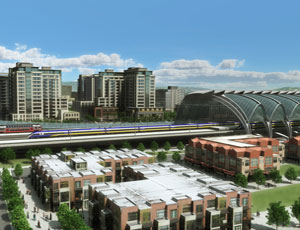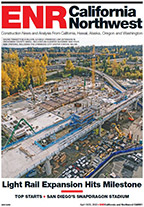With billions of dollars of state and federal funds anticipated, California can now pay some 80 engineering consultants on its planned 800-mile, $46-billion high-speed rail line. Already $5 million in debt for scoping and design work that occurred on the north-south express connector since the financially-strapped state froze infrastructure financing in December, the Pooled Money Investment Board approved a $29.1-million loan at its April 6 meeting after State Treasurer Bill Lockyer successfully sold $6.54 billion in bonds at the end of March.

The High Speed Rail Authority competed with $3.8 billion in other bond-funded projects for approximately $2.6 billion not already going to other debt service. "The treasurer is supportive of making sure the High Speed Rail Authority has sufficient funds, but they are in the same situation as 5,300 other projects," says Lockyer's spokesman Tom Dressler. The loan will fund operations until the end of the fiscal year in June. Another bond sale planned for mid-April could keep the project moving ahead.
Engineers worked for months without funding authorization to keep the project moving ahead. Only two firms had put the brakes on their work; most continued to perform essential environmental work while the state struggled to raise money. Robert Schaevitz, vice president in the Roseville, Calif. office of URS Corporation, which is working in joint venture with London-based Arup Group and Milburn, N.J.-based Hatch Mott MacDonald on the Fresno to Palmdale section doing preliminary engineering design, says his company hasn't been paid since October. "The Authority is ultimately good for the money," Schaevitz says.
A March 18 letter from Thomas Sheehy, chief deputy director for policy at the California Dept. of Finance, urged firms to "continue their work for the Authority as we work out the financing details in the next two weeks."
Mehdi Morshed, California High-Speed Rail executive director, warned that without the loan he would have to issue stop work orders. "There is no Plan B," he says.
After 10 years of uncertainty, the project has some momentum. Two EIRs have been completed. Scoping meetings are under way. In addition to $9 billion in bonds approved by voters in November, the project is well-positioned to qualify for a chunk of the $8 billion in American Recovery and Reinvestment Act (ARRA) funds dedicated to high-speed rail. If the traditional block grant process of giving California 13.5 percent of infrastructure funding is used, California's portion would be under a billion dollars. However, most other do not have rail projects capable of 110 mph defined in the ARRA guidelines, let alone the 220 mph proposed in California's ambitious project. While ARRA funds do not require local matching grants, timing is essential. Half of the money must be obligated by Sept. 1, 2009. The rest must be obligated by March 5, 2010. The interim guidelines from the Federal Railroad Administration for distribution of the infrastructure stimulus dollars are still being developed, but California rail advocates are confident.
"We are in an excellent position to take advantage of those funds," says Quentin L. Kopp, chairman of the High Speed Rail Authority. He identified $3.6 billion in specific items, including grade separations in the Los Angeles-to-Anaheim corridor, storage facilities in Los Angeles and the Bay Area and a heavy maintenance area in the Central Valley along with crossings and electrification that will meet the federal deadlines if the project stays on schedule. The $34 billion first phase is scheduled for completion in 2020.
"In addition to moving these projects forward as much as two years, [stimulus money would] help make it possible for us to use the state funds, which require a 50% match," says Morshed.
Tony Daniels, program director of the California High-Speed Rail Authority and senior vice president with New York City-based Parsons Brinckerhoff, says the slow down due to the few engineers suspending work due to nonpayment and postponing of non-essential engineering work could be made up in the long-term schedule.
In addition to cash flow challenges, the timeline is sensitive because of the size and controversy associated with the project. Washington, D.C.-based National Railroad Construction and Maintenance Association President Chuck Baker calls California's high-speed rail project the most massive undertaking since the transcontinental railroad was completed in 1869. The project is divided into eight sections with San Francisco to Anaheim scheduled to start first.
No tracks can be at grade level because of the high speeds. Therefore engineers are evaluating thousands of alternatives for routes that are elevated, underground, trenched or walled, including 600 planned road crossings. A number of sections will navigate mountain ranges or tunnel through them. Twin tunnel boring machines are being considered for a 16- to 20-mile tunnel through the Tehachapi Mountains near Bakersfield. Station siting, which will be considered during the public outreach period starting in mid-April, could also prove controversial as development is expected to flourish near the handful of stops on the 2-hour and 40-minute trip from San Francisco to Los Angeles.
Although the project will be the first of its kind in the United States, high-speed rail is utilized in Asia and Europe. Using best practices from these case studies, engineers are creating rules of particular applicability—holistic standards that meet or exceed U.S. Regulations.
In the end, building high-speed rail isn't that much different than traditional rail, according to Baker. Therefore, he expects rail giants like St. Joseph, Missouri-based Herzog Contracting Corp. and New York-based RailWorks Corporation to bid on the construction jobs when they are advertised, probably in Fall, 2010. Surprise language in the adjusted California state budget passed in February makes it possible for some of the contracts to come in the form of public-private partnerships, design-build or design-build-operate-maintain projects. California High Speed Rail Authority budget projections call for $8 billion of the funding to come from the private sector.
Joe Kneob, senior vice president at Herzog Contracting Corp. said that because of the stringent requirements and size of some of the contracts, "there are not an overabundance of companies that will bid on the construction project." He predicts that five or six teams will submit proposals and then be whittled down to a short list of three that will compete for sections of the work.
John August, executive vice president of RailWorks, confirms he will probably participate in a consortium to compete for some aspect of the project if and when the construction phase begins. "They still have a long way to go," August says.
Rob Kulat, spokesman for the Federal Railroad Administration, says 500 people from domestic and international companies, including IBM, have expressed interest in learning how the high-speed rail funds will be distributed.
Parsons Brinckerhoff's Daniels estimates phase one of the initial line will create 300,000 jobs, more when then Sacramento and San Diego lines are added. Once the project is complete, the associated development could create 400,000 jobs.


Post a comment to this article
Report Abusive Comment